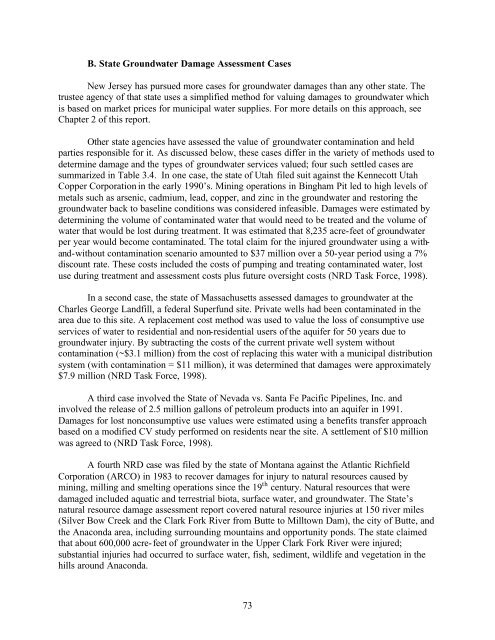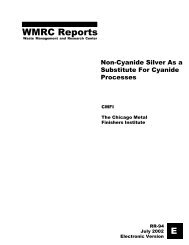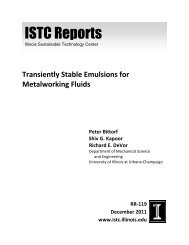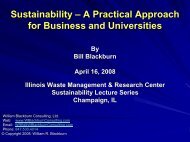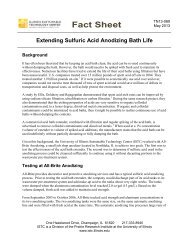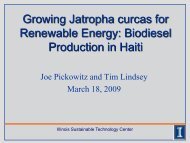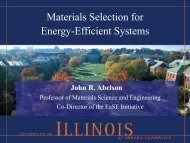Natural Resource Damage Assessment: Methods and Cases
Natural Resource Damage Assessment: Methods and Cases
Natural Resource Damage Assessment: Methods and Cases
Create successful ePaper yourself
Turn your PDF publications into a flip-book with our unique Google optimized e-Paper software.
B. State Groundwater <strong>Damage</strong> <strong>Assessment</strong> <strong>Cases</strong><br />
New Jersey has pursued more cases for groundwater damages than any other state. The<br />
trustee agency of that state uses a simplified method for valuing damages to groundwater which<br />
is based on market prices for municipal water supplies. For more details on this approach, see<br />
Chapter 2 of this report.<br />
Other state agencies have assessed the value of groundwater contamination <strong>and</strong> held<br />
parties responsible for it. As discussed below, these cases differ in the variety of methods used to<br />
determine damage <strong>and</strong> the types of groundwater services valued; four such settled cases are<br />
summarized in Table 3.4. In one case, the state of Utah filed suit against the Kennecott Utah<br />
Copper Corporation in the early 1990’s. Mining operations in Bingham Pit led to high levels of<br />
metals such as arsenic, cadmium, lead, copper, <strong>and</strong> zinc in the groundwater <strong>and</strong> restoring the<br />
groundwater back to baseline conditions was considered infeasible. <strong>Damage</strong>s were estimated by<br />
determining the volume of contaminated water that would need to be treated <strong>and</strong> the volume of<br />
water that would be lost during treatment. It was estimated that 8,235 acre-feet of groundwater<br />
per year would become contaminated. The total claim for the injured groundwater using a with<strong>and</strong>-without<br />
contamination scenario amounted to $37 million over a 50-year period using a 7%<br />
discount rate. These costs included the costs of pumping <strong>and</strong> treating contaminated water, lost<br />
use during treatment <strong>and</strong> assessment costs plus future oversight costs (NRD Task Force, 1998).<br />
In a second case, the state of Massachusetts assessed damages to groundwater at the<br />
Charles George L<strong>and</strong>fill, a federal Superfund site. Private wells had been contaminated in the<br />
area due to this site. A replacement cost method was used to value the loss of consumptive use<br />
services of water to residential <strong>and</strong> non-residential users of the aquifer for 50 years due to<br />
groundwater injury. By subtracting the costs of the current private well system without<br />
contamination (~$3.1 million) from the cost of replacing this water with a municipal distribution<br />
system (with contamination = $11 million), it was determined that damages were approximately<br />
$7.9 million (NRD Task Force, 1998).<br />
A third case involved the State of Nevada vs. Santa Fe Pacific Pipelines, Inc. <strong>and</strong><br />
involved the release of 2.5 million gallons of petroleum products into an aquifer in 1991.<br />
<strong>Damage</strong>s for lost nonconsumptive use values were estimated using a benefits transfer approach<br />
based on a modified CV study performed on residents near the site. A settlement of $10 million<br />
was agreed to (NRD Task Force, 1998).<br />
A fourth NRD case was filed by the state of Montana against the Atlantic Richfield<br />
Corporation (ARCO) in 1983 to recover damages for injury to natural resources caused by<br />
mining, milling <strong>and</strong> smelting operations since the 19 th century. <strong>Natural</strong> resources that were<br />
damaged included aquatic <strong>and</strong> terrestrial biota, surface water, <strong>and</strong> groundwater. The State’s<br />
natural resource damage assessment report covered natural resource injuries at 150 river miles<br />
(Silver Bow Creek <strong>and</strong> the Clark Fork River from Butte to Milltown Dam), the city of Butte, <strong>and</strong><br />
the Anaconda area, including surrounding mountains <strong>and</strong> opportunity ponds. The state claimed<br />
that about 600,000 acre-feet of groundwater in the Upper Clark Fork River were injured;<br />
substantial injuries had occurred to surface water, fish, sediment, wildlife <strong>and</strong> vegetation in the<br />
hills around Anaconda.<br />
73


